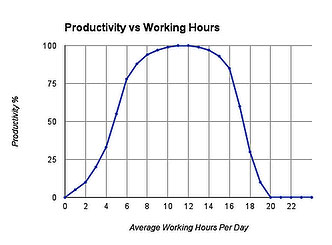My son, a member of the optimization generation, where pretty much every aspect of his life will be tracked, measured, and ultimately ruled by the Alg, posed a fascinating question to me the other day. He simply asked, “How much should I work?”
|
ADVERTISEMENT |
Now, the context for the question is that he’s undoubtedly a Type A who throws himself into his pursuits with unbelievable intensity, but his job is somewhat loosely structured so that he has a huge amount of discretion over how he allocates his hours and in particular how many hours he works at all. (Hint: He works a lot.)
So I traced an approximation of the following graph on a restaurant table top:

The X-axis is the average number of hours per day spent working. Zero is of course zero, and 24 means that he would be literally working 24 hours every day, seven days a week without sleeping. The Y-axis is job productivity measured in the percentage of one’s possible potential. So 100 percent is the best one can possibly be.
…
Add new comment